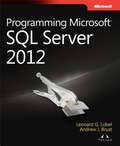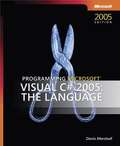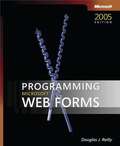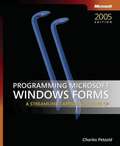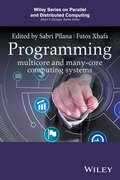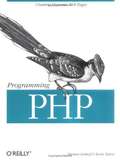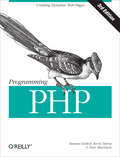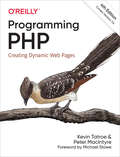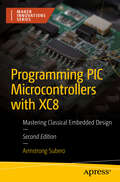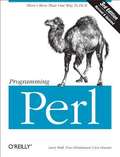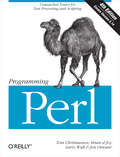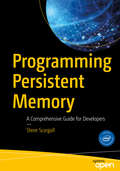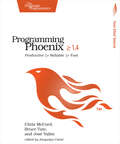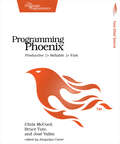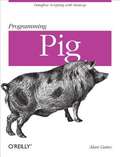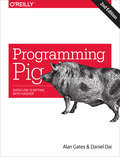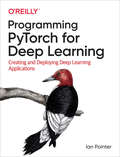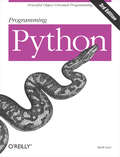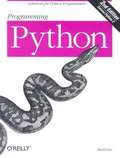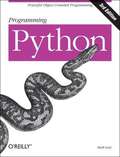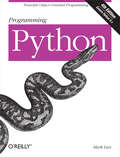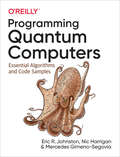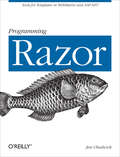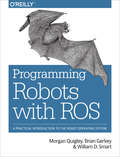- Table View
- List View
Programming Microsoft® SQL Server® 2012
by Andrew Brust Leonard LobelYour essential guide to key programming features in Microsoft® SQL Server® 2012 Take your database programming skills to a new level--and build customized applications using the developer tools introduced with SQL Server 2012. This hands-on reference shows you how to design, test, and deploy SQL Server databases through tutorials, practical examples, and code samples. If you're an experienced SQL Server developer, this book is a must-read for learning how to design and build effective SQL Server 2012 applications. Discover how to: Build and deploy databases using the SQL Server Data Tools IDE Query and manipulate complex data with powerful Transact-SQL enhancements Integrate non-relational features, including native file streaming and geospatial data types Consume data with Microsoft ADO.NET, LINQ, and Entity Framework Deliver data using Windows® Communication Foundation (WCF) Data Services and WCF RIA Services Move your database to the cloud with Windows AzureTM SQL Database Develop Windows Phone cloud applications using SQL Data Sync Use SQL Server BI components, including xVelocity in-memory technologies
Programming Microsoft® SQL Server™ 2008
by Andrew Brust Leonard Lobel Stephen Forte<div xmlns="http://www.w3.org/1999/xhtml"><p>Designed for developers and database administrators, this book teaches essential techniques for creating custom database applications and business intelligence solutions with SQL Server 2008.</p></div>
Programming Microsoft® Visual C#® 2005: The Language
by Donis MarshallGet the essential, straightforward information you need to master the core capabilities of Visual C# 2005. Both new and experienced developers get expert guidance, hands-on programming instruction, and practical examples to help advance their proficiency in developing applications for Microsoft Windows and the Web. Discover how to: Refine class usage with inheritance, polymorphism, and other strategies Implement generics to define a type-safe data structure Work with stacks, queues, arrays, dictionaries, and other collections Use iterators to implement and standardize enumerator patterns Know when to catch exceptions--and handle them locally or propagate them Interrogate metadata and facilitate late binding by using reflection Synchronize threads with locks, events, mutexes, and other tools Use the Microsoft Visual Studio Debugger and explore advanced debugging techniques and tools Get code samples on the Web
Programming Microsoft® Web Forms
by Douglas J. ReillyGet the focused, straightforward information you need to master the most common challenges in developing real-world Web Forms applications. Whether you're a new or experienced developer, you'll learn the essential techniques for exploiting new forms and controls in Microsoft ASP.NET 2.0--enabling you to write Web applications more quickly and with less code. Discover how to: Work with standard ASP.NET controls for common tasks Create your own user controls and custom server controls Lay out forms with HTML and Cascading Style Sheets Create common page elements just once with Master Pages Style your Web Forms with themes and skins Add Web Parts and allow users to personalize pages Access and edit data with Microsoft ADO.NET objects Bind data to your form controls--without adding any code Create security-enhanced Web applications Integrate your Web forms with Windows Forms applications PLUS--Get code samples on the Web
Programming Microsoft® Windows® Forms
by Charles PetzoldWhether you're a new or experienced developer, get the focused information you need to streamline application development using Windows Forms and Microsoft .NET Framework 2.0. Award-winning author Charles Petzold illuminates the essential concepts and techniques for exploiting Windows Forms capabilities--offering concise, eloquent instruction as always, along with ample code examples in C#. Discover how to: Understand the architecture of Windows Forms programs Add familiar Windows controls to your application, such as buttons, scroll bars, and text boxes Create toolbars, menus, and status bars, complete with text and bitmap images Enhance existing controls, combine multiple controls, or create custom controls from scratch Exploit dynamic layout with FlowLayoutPanel Support absolute, proportional, or auto-sized columns and rows with TableLayoutPanel Develop data-bound controls Display tabular data with the new DataGridView control--without writing extensive code PLUS--Build and deploy two real-world Windows Forms applications from the bottom up
Programming Multicore and Many-core Computing Systems
by Fatos Xhafa Sabri PllanaProgramming multi-core and many-core computing systems Sabri Pllana, Linnaeus University, Sweden Fatos Xhafa, Technical University of Catalonia, Spain Provides state-of-the-art methods for programming multi-core and many-core systems The book comprises a selection of twenty two chapters covering: fundamental techniques and algorithms; programming approaches; methodologies and frameworks; scheduling and management; testing and evaluation methodologies; and case studies for programming multi-core and many-core systems. Program development for multi-core processors, especially for heterogeneous multi-core processors, is significantly more complex than for single-core processors. However, programmers have been traditionally trained for the development of sequential programs, and only a small percentage of them have experience with parallel programming. In the past, only a relatively small group of programmers interested in High Performance Computing (HPC) was concerned with the parallel programming issues, but the situation has changed dramatically with the appearance of multi-core processors on commonly used computing systems. It is expected that with the pervasiveness of multi-core processors, parallel programming will become mainstream. The pervasiveness of multi-core processors affects a large spectrum of systems, from embedded and general-purpose, to high-end computing systems. This book assists programmers in mastering the efficient programming of multi-core systems, which is of paramount importance for the software-intensive industry towards a more effective product-development cycle. Key features: Lessons, challenges, and roadmaps ahead. Contains real world examples and case studies. Helps programmers in mastering the efficient programming of multi-core and many-core systems. The book serves as a reference for a larger audience of practitioners, young researchers and graduate level students. A basic level of programming knowledge is required to use this book.
Programming PHP
by Rasmus Lerdorf Kevin TatroeProgramming PHPis a comprehensive guide to PHP, a simple yet powerful language for creating dynamic web content. Filled with the unique knowledge of the creator of PHP, Rasmus Lerdorf, this book is a detailed reference to the language and its applications, including such topics as form processing, sessions, databases, XML, and graphics. Covers PHP 4, the latest version of the language.
Programming PHP: Creating Dynamic Web Pages (Apresspod Ser.)
by Rasmus Lerdorf Kevin Tatroe Peter MacintyreProgramming PHP, 2nd Edition, is the authoritative guide to PHP 5 and is filled with the unique knowledge of the creator of PHP (Rasmus Lerdorf) and other PHP experts. When it comes to creating websites, the PHP scripting language is truly a red-hot property. In fact, PHP is currently used on more than 19 million websites, surpassing Microsoft's ASP .NET technology in popularity. Programmers love its flexibility and speed; designers love its accessibility and convenience. As the industry standard book on PHP, all of the essentials are covered in a clear and concise manner. Language syntax and programming techniques are coupled with numerous examples that illustrate both correct usage and common idioms. With style tips and practical programming advice, this book will help you become not just a PHP programmer, but a good PHP programmer. Programming PHP, Second Edition covers everything you need to know to create effective web applications with PHP. Contents include: Detailed information on the basics of the PHP language, including data types, variables, operators, and flow control statements Chapters outlining the basics of functions, strings, arrays, and objects Coverage of common PHP web application techniques, such as form processing and validation, session tracking, and cookies Material on interacting with relational databases, such as MySQL and Oracle, using the database-independent PEAR DB library and the new PDO Library Chapters that show you how to generate dynamic images, create PDF files, and parse XML files with PHP Advanced topics, such as creating secure scripts, error handling, performance tuning, and writing your own C language extensions to PHP A handy quick reference to all the core functions in PHP and all the standard extensions that ship with PHP Praise for the first edition: "If you are just getting into the dynamic Web development world or you are considering migrating from another dynamic web product to PHP, Programming PHP is the book of choice to get you up, running, and productive in a short time." --Peter MacIntrye, eWeek "I think this is a great book for programmers who want to start developing dynamic websites with PHP. It gives a detailed overview of PHP, lots of valuable tips, and a good sense of PHP's strengths." --David Dooling, Slashdot.org
Programming PHP: Creating Dynamic Web Pages (Apresspod Ser.)
by Kevin Tatroe Peter MacIntyreWhy is PHP the most widely used programming language on the web? This updated edition teaches everything you need to know to create effective web applications using the latest features in PHP 7.4. You’ll start with the big picture and then dive into language syntax, programming techniques, and other details, using examples that illustrate both correct usage and common idioms. If you have a working knowledge of HTML, authors Kevin Tatroe and Peter MacIntyre provide many style tips and practical programming advice in a clear and concise manner to help you become a top-notch PHP programmer.Understand what’s possible when you use PHP programsLearn language fundamentals, including data types, variables, operators, and flow control statementsExplore functions, strings, arrays, and objectsApply common web application techniques, such as form processing, data validation, session tracking, and cookiesInteract with relational databases like MySQL or NoSQL databases such as MongoDBGenerate dynamic images, create PDF files, and parse XML filesLearn secure scripts, error handling, performance tuning, and other advanced topicsGet a quick reference to PHP core functions and standard extensions
Programming PIC Microcontrollers with XC8: Mastering Classical Embedded Design (Maker Innovations Series)
by Armstrong SuberoAre you tired of copying and pasting code into your embedded projects? Do you want to write your own code from scratch for microcontrollers and understand what your code is doing without all the frills and math? This book uses a practical approach to show you how to develop embedded systems with 8-bit PIC microcontrollers using the XC8 compiler. Written for those who want more than an Arduino, but less than the more complex microcontrollers on the market, this new edition is fully updated and covers embedded design principles such as foreground-background loops and event driven programming. You’ll learn how to interface with things like Motors, PID loop control and writing a browser-based monitoring system! This book is heavy on code, schematics, and images and focuses less on the theoretical aspects of using microcontrollers. Coverage includes writing a display driver, using the DAC for a multitude of waveform generation techniques, and building 8-bit IoT systems, real time telemetry, a countdown timer, and new peripherals. These topics are important if you want to learn more about PIC microcontroller devices as a whole. You'll also see the advantage that MPLAB X offers by running on Windows, Mac and Linux environments. You don't need to be a command line expert to work with PIC microcontrollers, so you can focus less on setting up your environment and more on your application. If you want to move beyond the Arduino, Programming PIC Microcontrollers with XC8 is your complete guide to understanding modern PIC microcontrollers. What You’ll Learn Set up the MPLAB X and XC8 compilers for microcontroller development Use GPIO and PPS Review EUSART and Software UART communications Use the eXtreme Low Power (XLP) options of PIC microcontrollers Explore wireless communications with WiFi and Bluetooth Who This Book Is For Those with basic electronic device and electronic equipment experience and some knowledge of the C programming and digital electronics. Also targeted towards students wanting a practical overview of microcontrollers outside of the classroom.
Programming Perl
by Tom Christiansen Jon Orwant Larry WallPerl is a powerful programming language that has grown in popularity since it first appeared in 1988. The first edition of this book, Programming Perl, hit the shelves in 1990, and was quickly adopted as the undisputed bible of the language. Since then, Perl has grown with the times, and so has this book. Programming Perl is not just a book about Perl. It is also a unique introduction to the language and its culture, as one might expect only from its authors. Larry Wall is the inventor of Perl, and provides a unique perspective on the evolution of Perl and its future direction. Tom Christiansen was one of the first champions of the language, and lives and breathes the complexities of Perl internals as few other mortals do. Jon Orwant is the editor of The Perl Journal, which has brought together the Perl community as a common forum for new developments in Perl. Any Perl book can show the syntax of Perl's functions, but only this one is a comprehensive guide to all the nooks and crannies of the language. Any Perl book can explain typeglobs, pseudohashes, and closures, but only this one shows how they really work. Any Perl book can say that my is faster than local, but only this one explains why. Any Perl book can have a title, but only this book is affectionately known by all Perl programmers as "The Camel." This third edition of Programming Perl has been expanded to cover version 5.6 of this maturing language. New topics include threading, the compiler, Unicode, and other new features that have been added since the previous edition.
Programming Perl: Unmatched power for text processing and scripting
by Tom Christiansen Jon Orwant Larry Wall Brian D FoyAdopted as the undisputed Perl bible soon after the first edition appeared in 1991, Programming Perl is still the go-to guide for this highly practical language. Perl began life as a super-fueled text processing utility, but quickly evolved into a general purpose programming language that’s helped hundreds of thousands of programmers, system administrators, and enthusiasts, like you, get your job done.In this much-anticipated update to "the Camel," three renowned Perl authors cover the language up to its current version, Perl 5.14, with a preview of features in the upcoming 5.16. In a world where Unicode is increasingly essential for text processing, Perl offers the best and least painful support of any major language, smoothly integrating Unicode everywhere—including in Perl’s most popular feature: regular expressions.Important features covered by this update include:New keywords and syntaxI/O layers and encodingsNew backslash escapesUnicode 6.0Unicode grapheme clusters and propertiesNamed captures in regexesRecursive and grammatical patternsExpanded coverage of CPANCurrent best practices
Programming Persistent Memory: A Comprehensive Guide for Developers
by Steve ScargallBeginning and experienced programmers will use this comprehensive guide to persistent memory programming. You will understand how persistent memory brings together several new software/hardware requirements, and offers great promise for better performance and faster application startup times—a huge leap forward in byte-addressable capacity compared with current DRAM offerings. This revolutionary new technology gives applications significant performance and capacity improvements over existing technologies. It requires a new way of thinking and developing, which makes this highly disruptive to the IT/computing industry. The full spectrum of industry sectors that will benefit from this technology include, but are not limited to, in-memory and traditional databases, AI, analytics, HPC, virtualization, and big data. Programming Persistent Memory describes the technology and why it is exciting the industry. It covers the operating system and hardware requirements as well as how to create development environments using emulated or real persistent memory hardware. The book explains fundamental concepts; provides an introduction to persistent memory programming APIs for C, C++, JavaScript, and other languages; discusses RMDA with persistent memory; reviews security features; and presents many examples. Source code and examples that you can run on your own systems are included. What You’ll LearnUnderstand what persistent memory is, what it does, and the value it brings to the industryBecome familiar with the operating system and hardware requirements to use persistent memoryKnow the fundamentals of persistent memory programming: why it is different from current programming methods, and what developers need to keep in mind when programming for persistenceLook at persistent memory application development by example using the Persistent Memory Development Kit (PMDK)Design and optimize data structures for persistent memoryStudy how real-world applications are modified to leverage persistent memoryUtilize the tools available for persistent memory programming, application performance profiling, and debugging Who This Book Is ForC, C++, Java, and Python developers, but will also be useful to software, cloud, and hardware architects across a broad spectrum of sectors, including cloud service providers, independent software vendors, high performance compute, artificial intelligence, data analytics, big data, etc.
Programming Phoenix 1.4: Productive |> Reliable |> Fast
by Bruce Tate Jose Valim Chris McCordDon't accept the compromise between fast and beautiful: you can have it all. Phoenix creator Chris McCord, Elixir creator Jose Valim, and award-winning author Bruce Tate walk you through building an application that's fast and reliable. At every step, you'll learn from the Phoenix creators not just what to do, but why. Packed with insider insights and completely updated for Phoenix 1.4, this definitive guide will be your constant companion in your journey from Phoenix novice to expert, as you build the next generation of web applications. Phoenix is the long-awaited web framework based on Elixir, the highly concurrent language that combines a beautiful syntax with rich metaprogramming. The best way to learn Phoenix is to code, and you'll get to attack some interesting problems. Start working with controllers, views, and templates within the first few pages. Build an in-memory context, and then back it with an Ecto database layer, complete with changesets and constraints that keep readers informed and your database integrity intact. Craft your own interactive application based on the channels API for the real-time applications that this ecosystem made famous. Write your own authentication plugs, and use the OTP layer for supervised services. Organize code with modular umbrella projects. This edition is fully updated for Phoenix 1.4, with a new chapter on using Channel Presence to find out who's connected, even on a distributed application. Use the new generators and the new ExUnit features to organize tests and make Ecto tests concurrent. This is a book by developers and for developers, and we know how to help you ramp up quickly. Any book can tell you what to do. When you've finished this one, you'll also know why to do it. What You Need:To work through this book, you will need a computer capable of running Erlang 18 or higher, Elixir 1.5 or higher, and Phoenix 1.4 or higher. A rudimentary knowledge of Elixir is also highly recommended.
Programming Phoenix: Productive |> Reliable |> Fast
by Bruce Tate Jose Valim Chris McCordDon't accept the compromise between fast and beautiful: you can have it all. Phoenix creator Chris McCord, Elixir creator Jose Valim, and award-winning author Bruce Tate walk you through building an application that's fast and reliable. At every step, you'll learn from the Phoenix creators not just what to do, but why. Packed with insider insights, this definitive guide will be your constant companion in your journey from Phoenix novice to expert, as you build the next generation of web applications.Phoenix is the long-awaited web framework based on Elixir, the highly concurrent language that combines a beautiful syntax with rich metaprogramming. The authors, who developed the earliest production Phoenix applications, will show you how to create code that's easier to write, test, understand, and maintain. The best way to learn Phoenix is to code, and you'll get to attack some interesting problems. Start working with controllers, views, and templates within the first few pages. Build an in-memory repository, and then back it with an Ecto database layer. Learn to use change sets and constraints that keep readers informed and your database integrity intact. Craft your own interactive application based on the channels API for the real-time, high-performance applications that this ecosystem made famous. Write your own authentication components called plugs, and even learn to use the OTP layer for monitored, reliable services. Organize your code with umbrella projects so you can keep your applications modular and easy to maintain.This is a book by developers and for developers, and we know how to help you ramp up quickly. Any book can tell you what to do. When you've finished this one, you'll also know why to do it.What You Need:To work through this book, you will need a computer capable of running Erlang 17 or better, Elixir 1.1, or better, Phoenix 1.0 or better, and Ecto 1.0 or better. A rudimentary knowledge of Elixir is also highly recommended.
Programming Pig
by Alan GatesThis guide is an ideal learning tool and reference for Apache Pig, the open source engine for executing parallel data flows on Hadoop. With Pig, you can batch-process data without having to create a full-fledged application--making it easy for you to experiment with new datasets. Programming Pig introduces new users to Pig, and provides experienced users with comprehensive coverage on key features such as the Pig Latin scripting language, the Grunt shell, and User Defined Functions (UDFs) for extending Pig. If you need to analyze terabytes of data, this book shows you how to do it efficiently with Pig. Delve into Pig's data model, including scalar and complex data types Write Pig Latin scripts to sort, group, join, project, and filter your data Use Grunt to work with the Hadoop Distributed File System (HDFS) Build complex data processing pipelines with Pig's macros and modularity features Embed Pig Latin in Python for iterative processing and other advanced tasks Create your own load and store functions to handle data formats and storage mechanisms Get performance tips for running scripts on Hadoop clusters in less time
Programming Pig: Dataflow Scripting with Hadoop
by Alan Gates Daniel DaiFor many organizations, Hadoop is the first step for dealing with massive amounts of data. The next step? Processing and analyzing datasets with the Apache Pig scripting platform. With Pig, you can batch-process data without having to create a full-fledged application, making it easy to experiment with new datasets.Updated with use cases and programming examples, this second edition is the ideal learning tool for new and experienced users alike. You’ll find comprehensive coverage on key features such as the Pig Latin scripting language and the Grunt shell. When you need to analyze terabytes of data, this book shows you how to do it efficiently with Pig.Delve into Pig’s data model, including scalar and complex data typesWrite Pig Latin scripts to sort, group, join, project, and filter your dataUse Grunt to work with the Hadoop Distributed File System (HDFS)Build complex data processing pipelines with Pig’s macros and modularity featuresEmbed Pig Latin in Python for iterative processing and other advanced tasksUse Pig with Apache Tez to build high-performance batch and interactive data processing applicationsCreate your own load and store functions to handle data formats and storage mechanisms
Programming PyTorch for Deep Learning: Creating and Deploying Deep Learning Applications
by Ian PointerTake the next steps toward mastering deep learning, the machine learning method that’s transforming the world around us by the second. In this practical book, you’ll get up to speed on key ideas using Facebook’s open source PyTorch framework and gain the latest skills you need to create your very own neural networks.Ian Pointer shows you how to set up PyTorch on a cloud-based environment, then walks you through the creation of neural architectures that facilitate operations on images, sound, text,and more through deep dives into each element. He also covers the critical concepts of applying transfer learning to images, debugging models, and PyTorch in production.Learn how to deploy deep learning models to productionExplore PyTorch use cases from several leading companiesLearn how to apply transfer learning to imagesApply cutting-edge NLP techniques using a model trained on WikipediaUse PyTorch’s torchaudio library to classify audio data with a convolutional-based modelDebug PyTorch models using TensorBoard and flame graphsDeploy PyTorch applications in production in Docker containers and Kubernetes clusters running on Google Cloud
Programming Python
by Mark LutzAlready the industry standard for Python users, ProgrammingPython fromO'Reilly just got even better. This third edition has been updated toreflect current best practices andthe abundance of changes introduced by the latest version of thelanguage, Python 2.5.Whether you're a novice or an advancedpractitioner, you'll find thisrefreshed book more than lives up to its reputation. ProgrammingPython, 3rd Edition, teaches you the rightway to code. It explains Python language syntax and programmingtechniques in a clear and concisemanner, with numerous examples that illustrate both correct usage andcommon idioms. By reading thiscomprehensive guide, you'll learn how to apply Python in real-worldproblem domains such as: GUI programmingInternet scriptingParallel processingDatabase managementNetworked applicationsProgramming Python, Third Edition coverseach of thesetarget domainsgradually, beginning with in-depth discussions of core concepts andthen progressing toward completeprograms. Large examples do appear, but only after you've learnedenough to understand their techniques andcode.Along the way, you'll also learn how to use the Python language inrealistically scaled programs--concepts such as Object-Oriented Programming (OOP) and code reuseare recurring side themes throughout thistext. If you're interested in Python programming, then this O'Reillyclassic needs to be within arm's reach. Thewealth of practical advice, snippets of code, and patterns of programdesign can all be put into use on adaily basis--making your life easier and more productive.Reviews of the second edition:"...about as comprehensive as any book can be."--Dr. Dobb's Journal"If the language had manuals, they would undoubtedlybe the texts from O'Reilly...'Learning Python' and 'Programming Python'are definitive treatments."--SD Times
Programming Python, 2nd Edition
by Mark LutzProgramming Python focuses on advanced applications of Python. Endorsed by Python creator Guido van Rossum, it demonstrates advanced Python techniques, and addresses software design issues such as reusability and object-oriented programming. The enclosed platform-neutral CD-ROM has book examples and various Python-related packages, including the full Python Version 2.0 source code distribution.
Programming Python, 3rd Edition
by Mark LutzAlready the industry standard for Python users, Programming Python from O'Reilly just got even better. This third edition has been updated to reflect current best practices and the abundance of changes introduced by the latest version of the language, Python 2.5. Whether you're a novice or an advanced practitioner, you'll find this refreshed book more than lives up to its reputation. Programming Python , Third Edition teaches you the right way to code. It explains Python language syntax and programming techniques in a clear and concise manner, with numerous examples that illustrate both correct usage and common idioms. By reading this comprehensive guide, you'll learn how to apply Python in real-world problem domains such as: GUI programming Internet scripting Parallel processing Database management Networked applications Programming Python , Third Edition covers each of these target domains gradually, beginning with in-depth discussions of core concepts and then progressing toward complete programs. Large examples do appear, but only after you've learned enough to understand their techniques and code. Along the way, you'll also learn how to use the Python language in realistically scaled programs--concepts such as Object Oriented Programming (OOP) and code reuse are recurring side themes throughout this text. If you're interested in Python programming, then this O'Reilly classic needs to be within arm's reach. The wealth of practical advice, snippets of code and patterns of program design can all be put into use on a daily basis--making your life easier and more productive. Reviews of the second edition: "...about as comprehensive as any book can be." --Dr. Dobb's Journal "If the language had manuals, they would undoubtedly be the texts from O'Reilly...'Learning Python' and 'Programming Python' are definitive treatments." --SD Times
Programming Python: Powerful Object-Oriented Programming
by Mark LutzIf you've mastered Python's fundamentals, you're ready to start using it to get real work done. Programming Python will show you how, with in-depth tutorials on the language's primary application domains: system administration, GUIs, and the Web. You'll also explore how Python is used in databases, networking, front-end scripting layers, text processing, and more. This book focuses on commonly used tools and libraries to give you a comprehensive understanding of Python’s many roles in practical, real-world programming.You'll learn language syntax and programming techniques in a clear and concise manner, with lots of examples that illustrate both correct usage and common idioms. Completely updated for version 3.x, Programming Python also delves into the language as a software development tool, with many code examples scaled specifically for that purpose.Topics include:Quick Python tour: Build a simple demo that includes data representation, object-oriented programming, object persistence, GUIs, and website basicsSystem programming: Explore system interface tools and techniques for command-line scripting, processing files and folders, running programs in parallel, and moreGUI programming: Learn to use Python’s tkinter widget libraryInternet programming: Access client-side network protocols and email tools, use CGI scripts, and learn website implementation techniquesMore ways to apply Python: Implement data structures, parse text-based information, interface with databases, and extend and embed Python
Programming Quantum Computers: Essential Algorithms and Code Samples
by Eric R. Johnston Nic Harrigan Mercedes Gimeno-SegoviaQuantum computers are poised to kick-start a new computing revolution—and you can join in right away. If you’re in software engineering, computer graphics, data science, or just an intrigued computerphile, this book provides a hands-on programmer’s guide to understanding quantum computing. Rather than labor through math and theory, you’ll work directly with examples that demonstrate this technology’s unique capabilities.Quantum computing specialists Eric Johnston, Nic Harrigan, and Mercedes Gimeno-Segovia show you how to build the skills, tools, and intuition required to write quantum programs at the center of applications. You’ll understand what quantum computers can do and learn how to identify the types of problems they can solve.This book includes three multichapter sections:Programming for a QPU—Explore core concepts for programming quantum processing units, including how to describe and manipulate qubits and how to perform quantum teleportation.QPU Primitives—Learn algorithmic primitives and techniques, including amplitude amplification, the Quantum Fourier Transform, and phase estimation.QPU Applications—Investigate how QPU primitives are used to build existing applications, including quantum search techniques and Shor’s factoring algorithm.
Programming Razor: Tools for Templates in ASP.NET MVC or WebMatrix
by Jess ChadwickTake Razor for a test drive and discover first hand how this scripting syntax simplifies the way you create dynamic, data-driven websites. With this concise guide, you’ll work with Razor syntax by building example websites with Microsoft WebMatrix and ASP.NET MVC. You'll quickly learn how Razor lets you combine code and content in a fluid and expressive manner on Windows-based servers.Programming Razor also explores components of the Razor API, and shows you how Razor templates are turned into rendered HTML. By the end of this book, you'll be able to create Razor-based websites with custom extensions that meet the specific needs of your projects.Use Razor with Microsoft WebMatrix to build a working blog, complete with dataOrganize and manage your web application, using Razor features for layouts, sections, and partial viewsCreate clean and effective ASP.NET MVC views with the Razor View EngineLearn how the Razor API interprets Razor templates and turns them into executable .NET codeImplement advanced techniques for exposing reusable code and sharing ASP.NET MVC views across projects
Programming Robots with ROS: A Practical Introduction to the Robot Operating System
by Brian Gerkey Morgan Quigley William D. SmartWant to develop novel robot applications, but don’t know how to write a mapping or object-recognition system? You’re not alone, but you’re certainly not without help. By combining real-world examples with valuable knowledge from the Robot Operating System (ROS) community, this practical book provides a set of motivating recipes for solving specific robotics use cases.Ideal for enthusiasts, from students in robotics clubs to professional robotics scientists and engineers, each recipe describes a complete solution using ROS open source libraries and tools. You’ll learn how to complete tasks described in the recipes, as well as how to configure and recombine components for other tasks. If you’re familiar with Python, you’re ready to go.Learn fundamentals, including key ROS concepts, tools, and patternsProgram robots that perform an increasingly complex set of behaviors, using the powerful packages in ROSSee how to easily add perception and navigation abilities to your robotsIntegrate your own sensors, actuators, software libraries, and even a whole robot into the ROS ecosystemLearn tips and tricks for using ROS tools and community resources, debugging robot behavior, and using C++ in ROS
